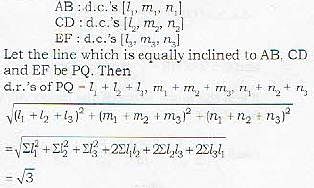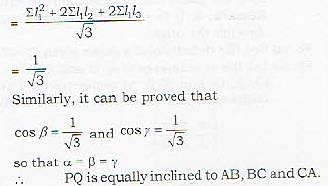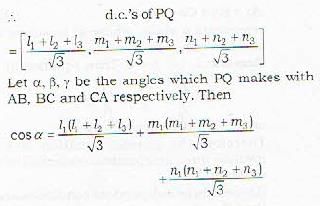Mathematics Exam > Mathematics Questions > The direction ratios of the line, which is eq...
Start Learning for Free
The direction ratios of the line, which is equally inclined to the three mutually perpendicular lines with direction cosines l1, m1, n1: l2, m2, n2 : l3, m3, n3; are given by
- a)l1+ m1+ n1: l2+ m2+ n2 : l3+ m3+ n3
- b)l1+l2+l3 ; m1+m2+m3; n1+n2+n3
- c)m1n2-m2n1; n1l2-n2l1; m2-l2m1
- d)none of the above
Correct answer is option 'B'. Can you explain this answer?
| FREE This question is part of | Download PDF Attempt this Test |
Verified Answer
The direction ratios of the line, which is equally inclined to the thr...
Proof: Let the three mutually perpendicular lines be






Most Upvoted Answer
The direction ratios of the line, which is equally inclined to the thr...
Proof: Let the three mutually perpendicular lines be






Free Test
FREE
| Start Free Test |
Community Answer
The direction ratios of the line, which is equally inclined to the thr...
Explanation:
To find the direction ratios of the line that is equally inclined to three mutually perpendicular lines, we can use the concept of direction cosines.
Concept:
Direction cosines are the cosines of the angles that a given line makes with the positive directions of the coordinate axes. The direction cosines are denoted by l, m, and n.
Solution:
Let the direction cosines of the three mutually perpendicular lines be l1, m1, n1; l2, m2, n2; and l3, m3, n3.
We need to find the direction ratios of the line that is equally inclined to these three lines.
The direction ratios of a line are defined as the ratios of the direction cosines.
So, the direction ratios of the line are l1/l2, m1/m2, and n1/n2.
Since the line is equally inclined to all three lines, the direction ratios of the line will be the same as the direction ratios of any one of the given lines.
Therefore, the direction ratios of the line are l1, m1, n1; l2, m2, n2; and l3, m3, n3.
Hence, the correct answer is option 'B': l1 l2 l3 ; m1 m2 m3; n1 n2 n3.

|
Explore Courses for Mathematics exam
|

|
Similar Mathematics Doubts
The direction ratios of the line, which is equally inclined to the three mutually perpendicular lines with direction cosines l1, m1, n1: l2, m2, n2 : l3, m3, n3; are given bya)l1+m1+n1: l2+m2+n2 : l3+m3+n3b)l1+l2+l3 ; m1+m2+m3; n1+n2+n3c)m1n2-m2n1; n1l2-n2l1; m2-l2m1d)none of the aboveCorrect answer is option 'B'. Can you explain this answer?
Question Description
The direction ratios of the line, which is equally inclined to the three mutually perpendicular lines with direction cosines l1, m1, n1: l2, m2, n2 : l3, m3, n3; are given bya)l1+m1+n1: l2+m2+n2 : l3+m3+n3b)l1+l2+l3 ; m1+m2+m3; n1+n2+n3c)m1n2-m2n1; n1l2-n2l1; m2-l2m1d)none of the aboveCorrect answer is option 'B'. Can you explain this answer? for Mathematics 2024 is part of Mathematics preparation. The Question and answers have been prepared according to the Mathematics exam syllabus. Information about The direction ratios of the line, which is equally inclined to the three mutually perpendicular lines with direction cosines l1, m1, n1: l2, m2, n2 : l3, m3, n3; are given bya)l1+m1+n1: l2+m2+n2 : l3+m3+n3b)l1+l2+l3 ; m1+m2+m3; n1+n2+n3c)m1n2-m2n1; n1l2-n2l1; m2-l2m1d)none of the aboveCorrect answer is option 'B'. Can you explain this answer? covers all topics & solutions for Mathematics 2024 Exam. Find important definitions, questions, meanings, examples, exercises and tests below for The direction ratios of the line, which is equally inclined to the three mutually perpendicular lines with direction cosines l1, m1, n1: l2, m2, n2 : l3, m3, n3; are given bya)l1+m1+n1: l2+m2+n2 : l3+m3+n3b)l1+l2+l3 ; m1+m2+m3; n1+n2+n3c)m1n2-m2n1; n1l2-n2l1; m2-l2m1d)none of the aboveCorrect answer is option 'B'. Can you explain this answer?.
The direction ratios of the line, which is equally inclined to the three mutually perpendicular lines with direction cosines l1, m1, n1: l2, m2, n2 : l3, m3, n3; are given bya)l1+m1+n1: l2+m2+n2 : l3+m3+n3b)l1+l2+l3 ; m1+m2+m3; n1+n2+n3c)m1n2-m2n1; n1l2-n2l1; m2-l2m1d)none of the aboveCorrect answer is option 'B'. Can you explain this answer? for Mathematics 2024 is part of Mathematics preparation. The Question and answers have been prepared according to the Mathematics exam syllabus. Information about The direction ratios of the line, which is equally inclined to the three mutually perpendicular lines with direction cosines l1, m1, n1: l2, m2, n2 : l3, m3, n3; are given bya)l1+m1+n1: l2+m2+n2 : l3+m3+n3b)l1+l2+l3 ; m1+m2+m3; n1+n2+n3c)m1n2-m2n1; n1l2-n2l1; m2-l2m1d)none of the aboveCorrect answer is option 'B'. Can you explain this answer? covers all topics & solutions for Mathematics 2024 Exam. Find important definitions, questions, meanings, examples, exercises and tests below for The direction ratios of the line, which is equally inclined to the three mutually perpendicular lines with direction cosines l1, m1, n1: l2, m2, n2 : l3, m3, n3; are given bya)l1+m1+n1: l2+m2+n2 : l3+m3+n3b)l1+l2+l3 ; m1+m2+m3; n1+n2+n3c)m1n2-m2n1; n1l2-n2l1; m2-l2m1d)none of the aboveCorrect answer is option 'B'. Can you explain this answer?.
Solutions for The direction ratios of the line, which is equally inclined to the three mutually perpendicular lines with direction cosines l1, m1, n1: l2, m2, n2 : l3, m3, n3; are given bya)l1+m1+n1: l2+m2+n2 : l3+m3+n3b)l1+l2+l3 ; m1+m2+m3; n1+n2+n3c)m1n2-m2n1; n1l2-n2l1; m2-l2m1d)none of the aboveCorrect answer is option 'B'. Can you explain this answer? in English & in Hindi are available as part of our courses for Mathematics.
Download more important topics, notes, lectures and mock test series for Mathematics Exam by signing up for free.
Here you can find the meaning of The direction ratios of the line, which is equally inclined to the three mutually perpendicular lines with direction cosines l1, m1, n1: l2, m2, n2 : l3, m3, n3; are given bya)l1+m1+n1: l2+m2+n2 : l3+m3+n3b)l1+l2+l3 ; m1+m2+m3; n1+n2+n3c)m1n2-m2n1; n1l2-n2l1; m2-l2m1d)none of the aboveCorrect answer is option 'B'. Can you explain this answer? defined & explained in the simplest way possible. Besides giving the explanation of
The direction ratios of the line, which is equally inclined to the three mutually perpendicular lines with direction cosines l1, m1, n1: l2, m2, n2 : l3, m3, n3; are given bya)l1+m1+n1: l2+m2+n2 : l3+m3+n3b)l1+l2+l3 ; m1+m2+m3; n1+n2+n3c)m1n2-m2n1; n1l2-n2l1; m2-l2m1d)none of the aboveCorrect answer is option 'B'. Can you explain this answer?, a detailed solution for The direction ratios of the line, which is equally inclined to the three mutually perpendicular lines with direction cosines l1, m1, n1: l2, m2, n2 : l3, m3, n3; are given bya)l1+m1+n1: l2+m2+n2 : l3+m3+n3b)l1+l2+l3 ; m1+m2+m3; n1+n2+n3c)m1n2-m2n1; n1l2-n2l1; m2-l2m1d)none of the aboveCorrect answer is option 'B'. Can you explain this answer? has been provided alongside types of The direction ratios of the line, which is equally inclined to the three mutually perpendicular lines with direction cosines l1, m1, n1: l2, m2, n2 : l3, m3, n3; are given bya)l1+m1+n1: l2+m2+n2 : l3+m3+n3b)l1+l2+l3 ; m1+m2+m3; n1+n2+n3c)m1n2-m2n1; n1l2-n2l1; m2-l2m1d)none of the aboveCorrect answer is option 'B'. Can you explain this answer? theory, EduRev gives you an
ample number of questions to practice The direction ratios of the line, which is equally inclined to the three mutually perpendicular lines with direction cosines l1, m1, n1: l2, m2, n2 : l3, m3, n3; are given bya)l1+m1+n1: l2+m2+n2 : l3+m3+n3b)l1+l2+l3 ; m1+m2+m3; n1+n2+n3c)m1n2-m2n1; n1l2-n2l1; m2-l2m1d)none of the aboveCorrect answer is option 'B'. Can you explain this answer? tests, examples and also practice Mathematics tests.

|
Explore Courses for Mathematics exam
|

|
Suggested Free Tests
Signup for Free!
Signup to see your scores go up within 7 days! Learn & Practice with 1000+ FREE Notes, Videos & Tests.


















